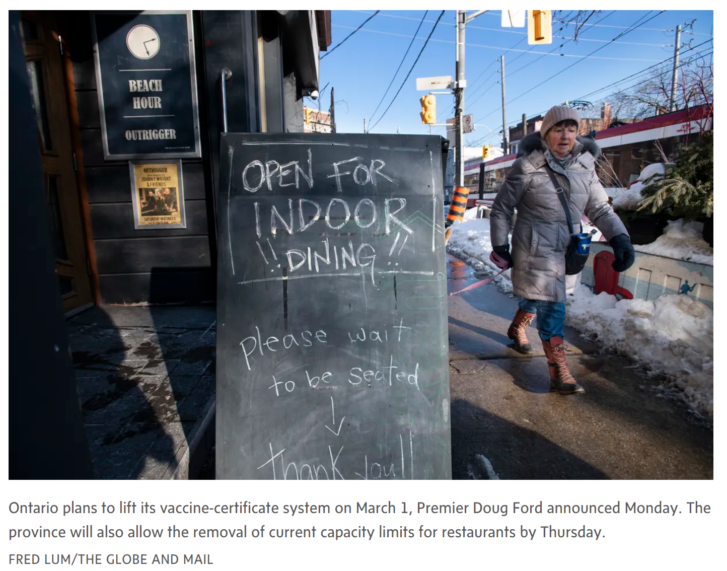Ontario plans to scrap its vaccine-certificate system in two weeks and end capacity limits for restaurants, bars and gyms in days, in a significant acceleration of plans to remove COVID-19 restrictions.
Masking rules are to remain in place for now. And businesses will be free to continue using the province’s proof-of-vaccination system if they choose.
Ontario Premier Doug Ford and his Chief Medical Officer of Health Kieran Moore said on Monday that hospital admissions are declining steeply and the vaccination rate is high enough to allow the province to speed up its previously announced timeline for lifting restrictions.

The imminent end of Ontario’s QR-code vaccine passport system for restaurants and other higher-risk businesses follows moves by Saskatchewan, Alberta and Manitoba to either eliminate or announce plans to scrap their own similar regimes.
Mr. Ford said his government is making the changes based on a recommendation from Dr. Moore on the weekend and not in an attempt to appease the protesters clogging streets in Ottawa or those who blockaded the Ambassador Bridge between Windsor and Detroit.
“Let me be very clear, we’re moving in this direction because it’s safe to do so,” Mr. Ford said. “Today’s announcement is not because of what’s happening in Ottawa or Windsor, but despite it.”
Ontario is also opening up Pfizer booster doses as of Friday to those who are aged 12 to 17 and six months past their second dose.
In Quebec, Premier François Legault said he would discuss his province’s vaccine passport system with public-health authorities at a weekly meeting on Monday evening. Health Minister Christian Dubé has said the province may suspend the vaccine passport if the COVID-19 situation continues to improve. Mr. Legault said Monday the Health Minister’s plan “is to get rid of the pass as soon as we get the okay from public health.”
Under Ontario’s plans, as of Thursday at 12:01 a.m., indoor private gatherings will be limited to 50 people, up from 10. The limit will be 100 for outdoor gatherings. Capacity limits will be removed for restaurants and bars without dancefloors, gyms and cinemas, event spaces, casinos and bingo halls. Sports arenas will be limited to 50-per-cent capacity, along with concert venues and theatres. Nightclubs and similar venues will have 25-per-cent capacity limits.
But as of March 1, if COVID-19 numbers continue to improve, all these capacity limits will be lifted – along with the province’s mandatory vaccine passport system.
Mask rules will remain “for just a little bit longer,” Mr. Ford said.
While the wave of infections driven by the virus’s more contagious Omicron variant is subsiding, Dr. Moore said hospital admissions and testing results will be monitored closely before any decisions are made about masking. He said that the province’s gradual approach means it waits two weeks to see the impact of any changes before further lifting more restrictions.
Ontario’s hospital admissions have plummeted from a peak in this latest wave of more than 4,000 patients to the 1,369 reported on Monday, with 394 COVID-19 patients in intensive care.
The province’s vaccination rates are high, Dr. Moore said. Of Ontarians aged 12 and over, 92 per cent have at least one vaccine dose, with almost 6.8 million (compared with a total population of 14.57 million) receiving booster doses.
The Ontario government also says that local public-health units will be able to impose their own restrictions if needed to “manage COVID-19 over the long term.”
The province’s previous timeline wouldn’t have further eased its pandemic rules until Feb. 21 but would have phased out all capacity limits March 14, while leaving vaccine certificates in place.
Peter Juni, scientific director of the province’s COVID-19 Science Advisory Table, said Monday’s announcement of an accelerated easing of restrictions is supported by the data. He said Ontarians, thanks to boosters and the recent wave of infections, have developed a “strong wall of immunity against Omicron.” But he said future variants could mean reimposing measures.
He also said maintaining the current two-dose vaccine-certificate system makes little sense. Transmission of Omicron with two doses is still possible, although the vaccines do help keep people out of hospital. But mandating three doses would be difficult, he said, since millions of Ontarians were infected with Omicron in January and must now wait three months to receive their booster, according to national vaccine guidelines.
Ontario Opposition NDP Leader Andrea Horwath said Mr. Ford was “caving” to “anti-vaxxers.” But Ontario Liberal Leader Steven Del Duca supported the easing of restrictions, noting it had been okayed by Dr. Moore.
In his remarks, Mr. Ford also made a plea for unity and made an apparent reference to his adult daughter, Krista Haynes, who has been a vocal vaccine opponent on social media. He said the pandemic had “fractured us as a society” over the vaccines, public-health measures and the limits of personal freedoms.
“I’ve experienced this in my own family. It’s been one of the hardest things my family and I have ever gone through,” the Premier said.
Meanwhile in Ottawa, Prime Minister Justin Trudeau said changes to federal pandemic restrictions would be announced “in the coming days.” Earlier in the day, MPs defeated a Conservative Party motion calling on the government to table a plan for the lifting of all federal mandates and restrictions by the end of the month.
Article From: Global and Mail
Author: JEFF GRAY

